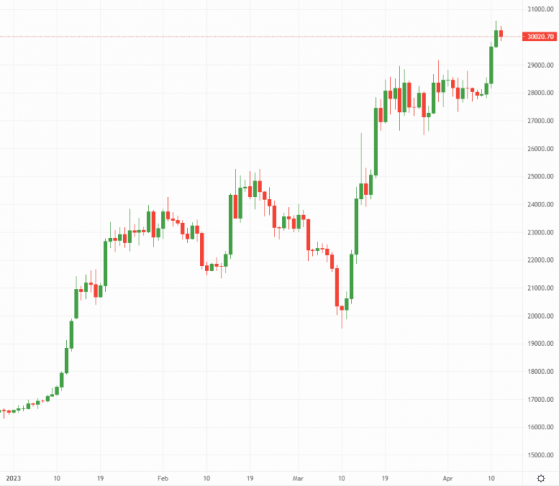Proactive Investors - Bitcoin (BTC) had another shot of bullishness in the closing hours of yesterday’s US trading session, peaking at US$30,550 on the BTC/USDT pair before knocking back to US$29,885 when Asia markets took over.
Sustaining bitcoin’s price near 30k will be the core battleground for the markets in the short term, particularly with the US inflation report due to drop this afternoon.
Consensus has year-on-year inflation dropping from 6% to 5.2% in March; achieving this would drive a dovish wedge into monetary policy which would theoretically be a bullish motivation for bitcoin and other riskier assets.
That is what was arguably historically the case anyway, but bitcoin has attracted noticeably different catalysts this year, acting more in line with safe-haven assets like gold rather than traditionally correlated equities.
So a softer inflation read may bolster bitcoin’s price to an extent, but proving itself as a worthy component of a diversified portfolio in the same way as physical gold will probably be a more influential factor.
Will inflation read hit or support bitcoin (BTC)? – Source: currency.com
Underscoring the importance of price stability at the key 30k level, Edward Moya, senior market analyst at OANDA said: “Bitcoin’s ceiling remains the US$30,000 level and how it behaves once it trades north of it will determine if the next major bull phase is upon us,”
There does look to be diversification on the derivatives front, with Victoria Scholar at interactive investor surmising that “shorts have been getting squeezed this year, prompting more buying as the bears rush to cover their losing positions”.
We’ll find out the degree of influence macroeconomics have on bitcoin in 2023 after the inflation read is released at 1.30pm UK time.
Ethereum’s Shanghai moment
Ethereum (ETH) has other catalysts on its mind with the Shanghai upgrade due to take place this evening.
For the uninitiated, the Shanghai upgrade will allow people to unlock their “staked” ether coins from hibernation. ETH holders were able to stake their coins prior to last year’s switch to proof of stake (PoS) consensus as a way to help with the upgrade and earn yield as compensation.
It gets very complex very easily, but the rub is: Unlocking the approximately US$34bn of currently staked ether coins will inevitably dilute the existing circulating supply.
Adding to bearish anxiety are fears that the Shanghai upgrade will lead to a large-scale sell-off as stakers seek to either take profits or cut their losses depending on what side of the spot price they’re on.
However, Shanghai is a staged process, so an immediate US$34bn capitulation is out of the question, but the risk to ETH’s short-term price cannot be ignored.
At the time of writing, ETH/USDT was changing hands at US$1,869, having dipped 1% on Tuesday and another 1% this morning, thus underperforming against the bitcoin benchmark.
Week on week, ETH/USDT is over 2% lower, while BTC/USDT remains over 5% higher. Clearly there are so short-term Shanghai fears.
In the altcoin space
With the markets mainly focused on ether and bitcoins, the top-20 altcoin set has been broadly uneventful of late.
Solana (SOL) is the one exception, having rallied 10% yesterday and another 2% this morning to bring the highly scalable proof-of-stake blockchain’s market capitalisation close to US$9.2bn.
SOL’s momentum precedes tomorrow’s scheduled launch of the Solana-powered ‘Saga’ Android smartphone.
Binance’s BNB token is also in the green week on week, while Ripple (XRP), Polygon (MATIC), Polkadot (DOT) and Litecoin (LTC) have all flipped negative.
Dogecoin (DOGE) is bottom of the pile with 15% in losses after Elon Musk abandoned his brief flirtation with a DOGE-themed Twitter website.
Global cryptocurrency market cap currently stands at US$1.22tn after dipping 1.4% overnight, while total value locked in the decentralised finance (DeFi) space also fell 1.4% to US$50.7bn.
Read more on Proactive Investors UK
